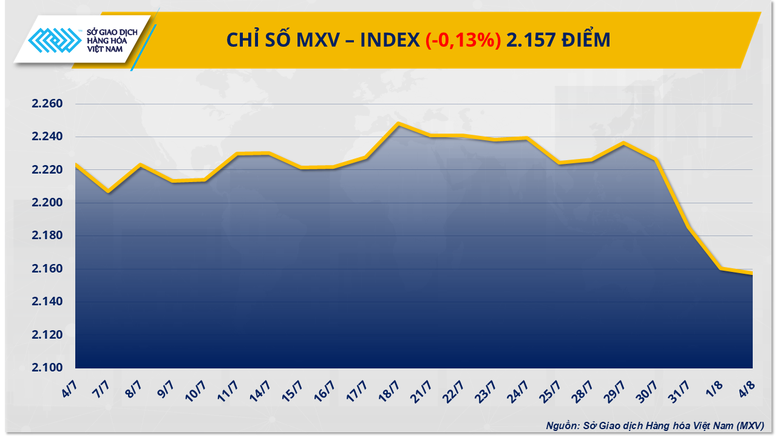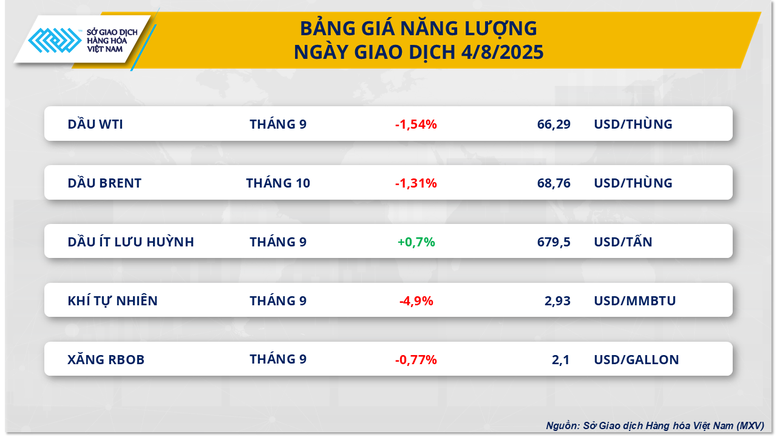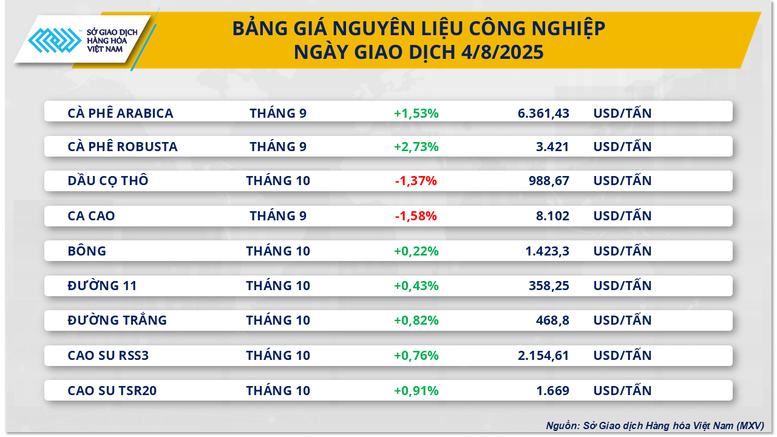
Brent oil prices fall to one-week low
According to MXV, the energy market yesterday witnessed red dominating the price list with 4/5 commodities simultaneously weakening. In particular, Brent oil price fell to the lowest level in the past week, stopping at 68.8 USD/barrel, corresponding to a decrease of 1.31%, WTI oil price was also not out of the trend when losing more than 1.5% to 66.29 USD/barrel.
The main reason for the pressure on the oil market yesterday was the decision of the Organization of the Petroleum Exporting Countries and its allies (OPEC+) to continue to maintain the plan to increase production by 547,000 barrels/day in September. This decision was made after an online meeting on August 3 with the participation of eight key members including Saudi Arabia, Russia, Iraq, the United Arab Emirates, Kuwait, Kazakhstan, Algeria and Oman.

With this latest move, OPEC+ has completed the reversal of all production cuts implemented in 2023, with a total scale of up to 2.2 million barrels/day. In addition, OPEC+ also announced an additional production increase for the UAE, bringing the total increase to 2.5 million barrels/day, equivalent to about 2.4% of current global crude oil demand.
In a statement after the meeting, OPEC+ stressed that the decision was based on the healthy market operation and low oil reserves in many countries. At the same time, many opinions said that this was a step to expand market share in the context of the US Energy Information Administration (EIA) forecasting a decrease in US crude oil supply for the rest of 2025.
However, the OPEC+ decision has also raised concerns about a global oil supply glut, accompanied by forecasts of a sharp decline in energy demand. In its latest oil price forecast, Goldman Sachs, while maintaining its previous forecast, also warned that oil demand growth this year will likely fall by 800,000 barrels per day.
Goldman Sachs cited the White House’s tariff policies and the dim macroeconomic outlook in the world’s largest economy as the reasons. In addition, turmoil in Washington has caused investors to seek safer havens amid concerns about a gloomy economic outlook that has weakened energy demand for business production.
In data released by the EIA on July 31, US retail gasoline demand in May continued to fall to its lowest level since 2020, despite a sharp drop in oil prices during that period. Many analysts believe that this slow start to the peak travel season of people may be due to the uncertainty in the policies announced by the White House at that time.

However, in contrast to the gloomy general picture, the industrial raw material group recorded a bright spot thanks to the strong recovery of coffee prices. Specifically, Arabica coffee prices increased by more than 1.5% to 6,361 USD/ton, while Robusta coffee prices jumped nearly 3% to 3,421 USD/ton - a high in recent sessions.
According to MXV, the increase in world coffee prices was strongly boosted by the continuous appreciation of the Brazilian real in the last two sessions, increasing by a total of 1.8% against the USD. This made the country's coffee exports less attractive, thereby creating a push for prices.
In addition, Brazilian farmers’ cautious selling sentiment due to low domestic prices has further tightened supply. In fact, the latest report from Cecafe shows that Brazil’s green coffee exports in July only reached 2.43 million 60-kg bags, down 28% compared to the same period last year.
Source: https://baochinhphu.vn/sac-do-phu-thi-truong-nang-luong-ca-phe-thanh-diem-sang-102250805092027947.htm



































































































Comment (0)